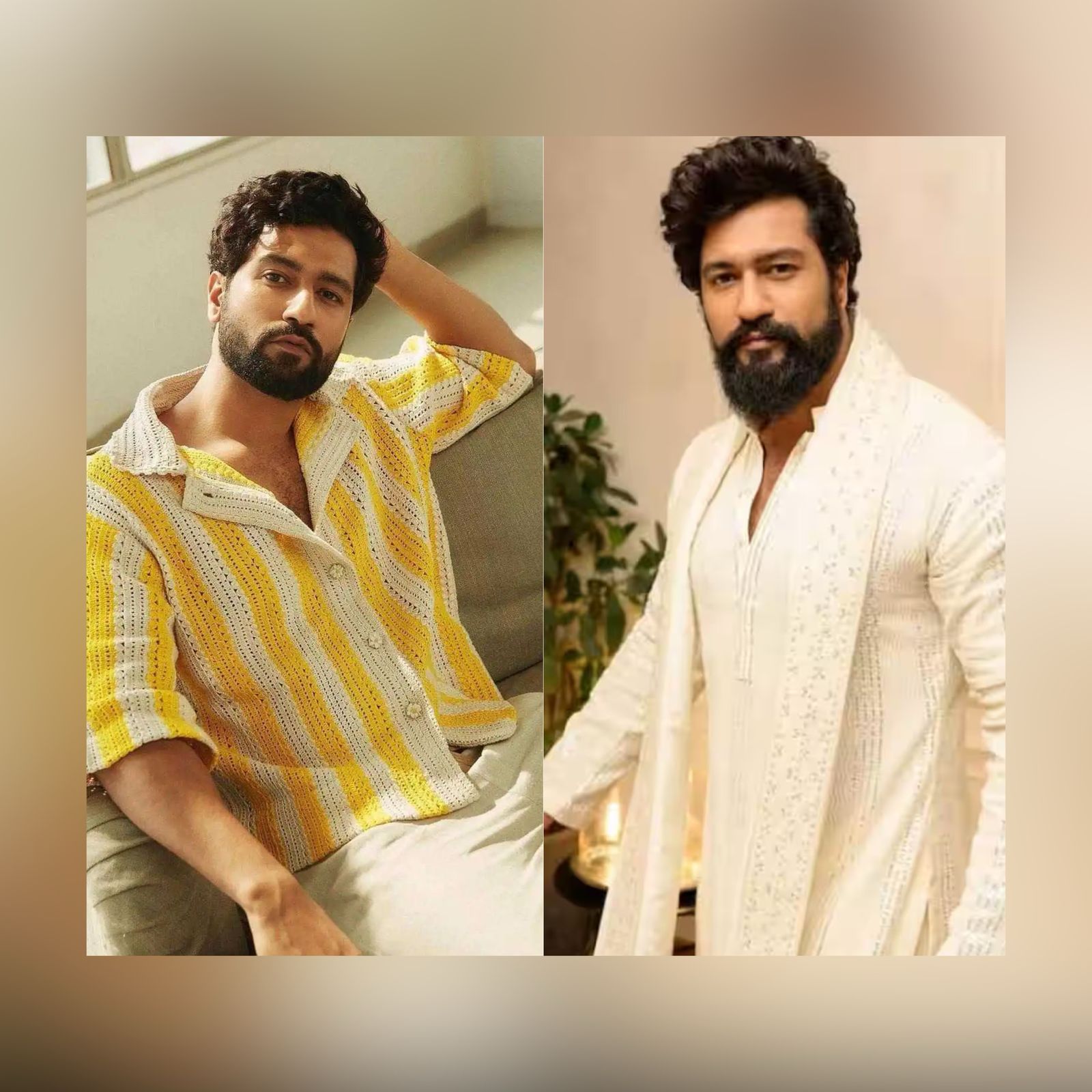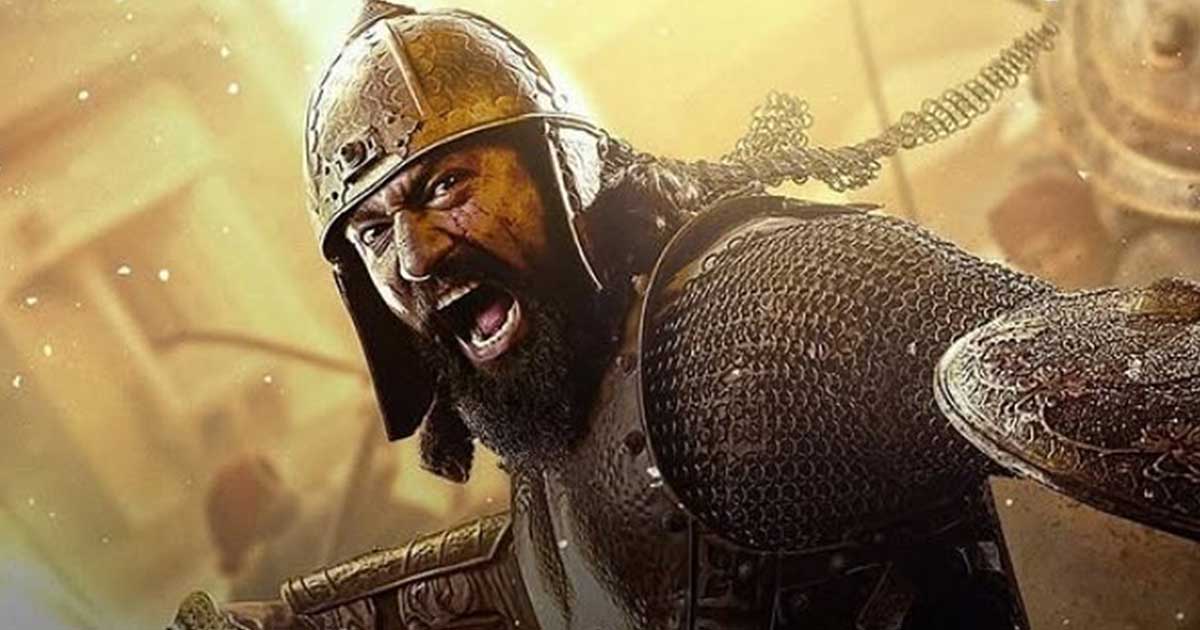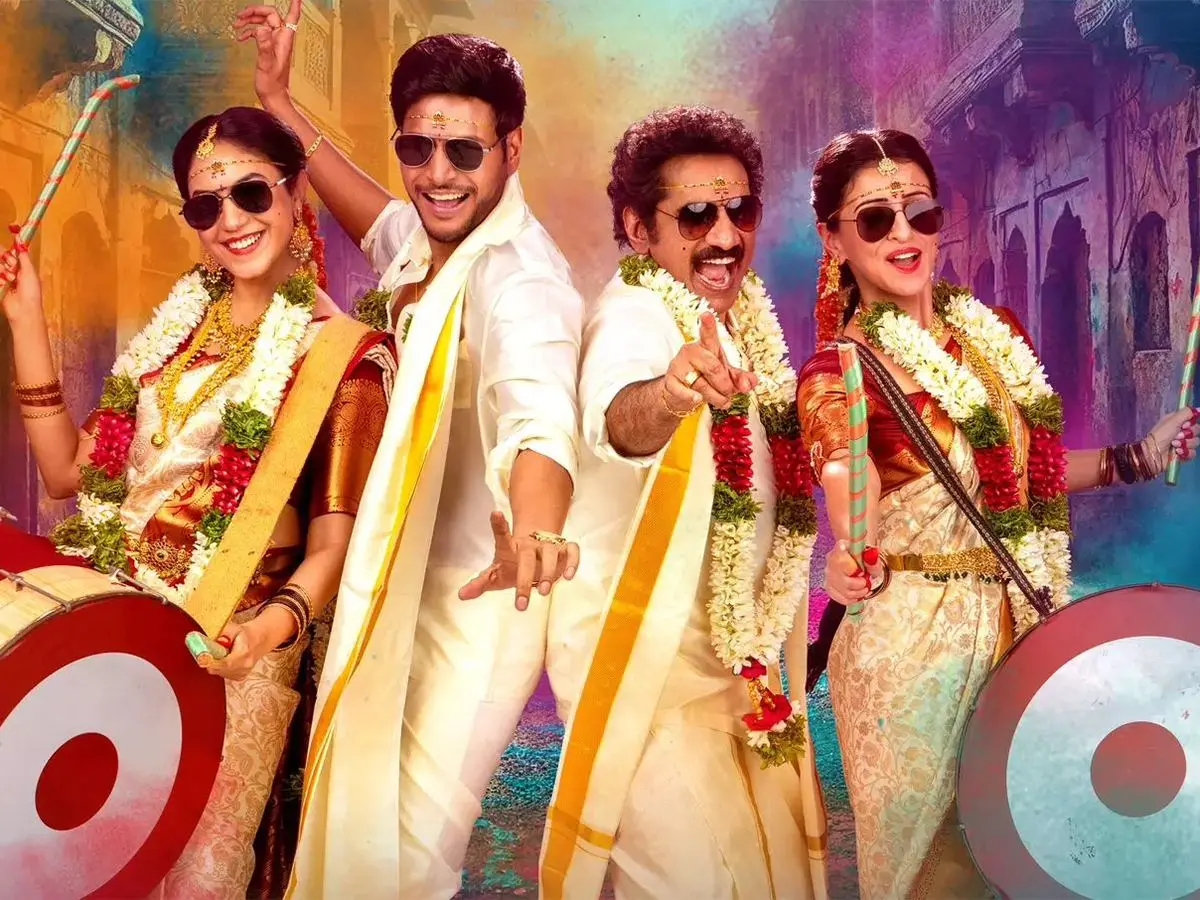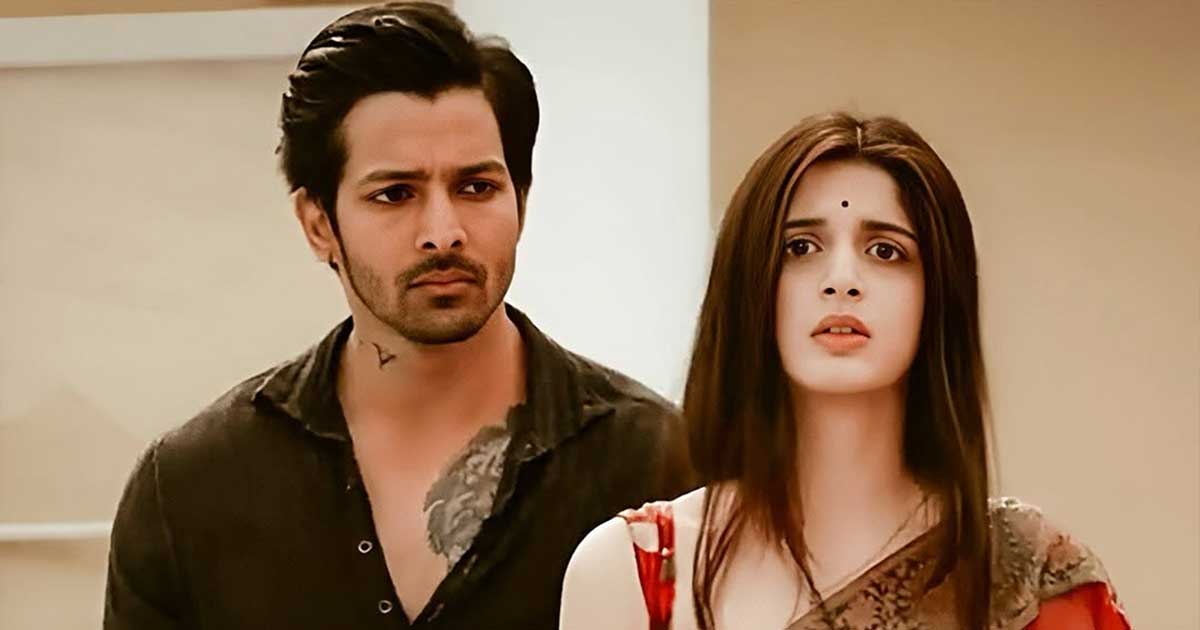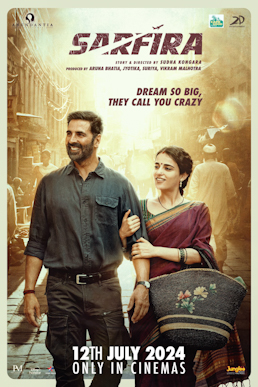
Adaptation on autopilot – Beyond Bollywood
That’s how it feels, provided one hasn’t watched the original Soorarai Pottru [2020]. Akshay Kumar and Radhika Madan put on a sincere show.
Rating: ⭐️⭐️💫 (2.5 / 5)
By Mayur Lookhar
Year 2003. Not enough fuel, a Deccan Air flight seeks to land at Chennai airport but is surprisingly denied permission. Its owner, Vir Mhatre, bizarrely barges into the ATC (Air Traffic Control) tower, grabs the phone, and directs his pilot to land at a military runway nearby. Now that is a true sarfira (crazy) for you. The pilot has no option; he flies over the parading officers for a hard landing, with one wheel on fire. All’s well that ends well, but there’ll be hell to pay for landing at a military strip without permission.
There couldn’t be a more turbulent beginning to this story. Before viewers can decipher what’s hit them, director Sudha Kongara takes us back to 1998 in Jarandeshwar, a humble village in Maharashtra. Rani’s family is heading to Vir’s house, hoping their haughty daughter won’t reject another prospective groom. Kongara is mindful of the age gap between Akshay Kumar and Radhikka Madan, making it a point to highlight that Vir is significantly older than Rani.
This isn’t a typical meeting between two families. The Mhatres are poorer than Rani’s family, and their house resembles temporary accommodation at a construction site. No one is dressed for the occasion. Uncombed curly hair and sporting a stubble, Vir is lounging on a charpoy when he spots a pretty but arrogant-looking woman pass by him. The woman, too, maintains eye contact. Words begin to flow in their minds as both Vir and Rani are unimpressed by each other. Vir soon informs her that the house doesn’t even have a toilet. No job, no decent accommodation, family property mortgaged—Vir’s only asset is an idea to start India’s first low-cost airline. Rani listens to him and then reveals her dream to run a bakery, but her parents oppose the idea of their daughter being enterprising. Having been rejected by many girls before, Vir doesn’t hesitate to say yes to this proposal. Rani, however, will make her mind tomorrow.
The next morning, as Rani and her family prepare to leave, she confidently tells Vir that she is declining the proposal. It’s not because she isn’t impressed by his honesty, but because she doesn’t want to be his second love. Says Rani, “Your first love is the plane, mine is the bakery. Let’s pursue our dreams first, and if we’re still single, we can consider marriage then.”
Pragmatism prevailed, yet these moments between Vir and Rani make you forget that Sarfira [2024] is an aspirational story. The family audience is eager to see this sarfira meet this sarfiri again. There’s the small matter of a big aviation dream that first needs to take off, though.
Bollywood has a long history of remakes. Lately, artistes and filmmakers prefer to use the term adaptation. How often do we hear Bollywood say that certain stories haven’t reached larger Indian audiences, especially the vast Hindi-speaking population? This sentiment holds true for desi adaptations of international content. However, with the increasing popularity of Pan-India South Indian films, are these stories truly unheard of for Hindi audiences? OTT networks often capitalize on popular South Indian content. Then there’s Manish Shah’s Goldmines Telefilms, a haven for dubbed versions of popular South Indian films on YouTube. Soorarai Pottru [2020] and its dubbed Hindi version called Udaan are available on Prime Video.

The pandemic had forced writer-director Sudha Kongara to release her film, starring Suriya, directly on digital. With the world confined indoors, surely cinephiles across the country and even the diaspora must have seen or at least heard of Soorarai Pottru. The news of the makers submitting their film for Oscars (not as India’s official entry) had also made headlines. If many at the press show are not aware that Sarfira is an official adaptation of Soorarai Pottru, then we can assume that the vast and humble Hindi-speaking population is still not aware of the Tamil film.

Though not certified biopics, Soorarai Pottru and now Sarfira are both inspired by the book Simply Fly: A Deccan Odyssey by Captain G.R. Gopinath – the man who introduced India’s first low-cost airline, Air Deccan. Here’s a man who came with the disruptive idea of airfares as low as ₹1. Hailing from a poor background himself, Gopinath aimed to bridge the class and caste divide by making air travel possible for the poor. Of course, such ridiculously low fares could only be limited to a few seats.
Gopinath’s vision, especially his desire to break class and caste barriers, is indeed a hallmark of a true social entrepreneur and a shining example of CSR (Corporate Social Responsibility). However, in the context of the aviation business, populist measures may not necessarily be commercially viable. Besides, they can have a counter-effect on the overall health of the industry. Let’s not forget, there are numerous external factors that determine airfares. Is it then appropriate to project Captain Gopinath as a hero? Aviation experts may be divided on this, but the idea of a one-rupee flight ticket surely makes for a great cinematic story.

The original Tamil film was packed with typical high-pitched melodrama. The Hindi adaptation, though, is slightly more measured in its narrative approach. However, as an adaptation, the Sarfira screenplay largely seems to run on autopilot. Apart from a different location where Mhatre encounters the then president Dr. A.P.J. Abdul Kalam, and Kongara omitting a misogyny scene, it’s challenging to distinguish Sarfira from the original. Yet, the film isn’t lost in translation. Pooja Tolani’s adept dialogues ensure consistent engagement. For those who haven’t seen the original, Sarfira will likely come across as a breath of fresh air. You can put your mobile phones on airplane mode and not miss it.
Unfortunately, this reviewer had watched Soorarai Pottru for the first time just 24 hours ago (on Tuesday). Honestly, we expected Sarfira producers to temporarily discontinue the digital streaming of Soorarai Pottru for a few weeks, as seen with the release of some Hindi adaptations before. Did having a rival digital partner complicate things for Sarfira? That is an altogether different tale.
What’s undeniable is that, with the same director at the helm, Sarfira has largely stayed true to the original story. Kongara has paid tribute to the name Nedumaaran, Suriya’s leading character in the original. Here, the name is acquired by Mhatre’s senior officer (played by R. Sarathkumar) in the Indian Air Force. The IAF was a brief part of Mhatre’s life, but this is essentially a film about civil aviation. The huge thanks to the IAF in the opening credits are a sign of respect, but it momentarily lulls viewers into believing that this could be a film about the Indian Air Force.
There’s a predictable surprise in the end credits. Captain Gopinath’s vision was to see the common man fly, and this comes through not just in the narrative, but also in Kongara’s decision to have a laborer as the logo/mascot for Deccan Air. Interestingly, he slightly resembles Captain Gopinath.

Akshay Kumar’s prolonged poor form is well chronicled. The opening weekend will decide Sarfira’s fate, but it’s nice to see that the seasoned actor has finally chosen a good story and, importantly, put his heart into pulling off this character. A common aspect in many rags-to-riches stories is the burning desire to achieve the impossible at all costs. Every dream faces many hurdles, and Captain Gopinath had turbo-size obstacles to overcome. Naturally, there will be times when frustration comes out through words. Such straight-talking can often be mistaken for insolence by the average person.
Director Kongara has spoken about taking a week for Akshay and her to be on the same page. Phew, that’s not an ideal start, but based on this performance, she shouldn’t have much to complain about now. The topography naturally changes from Tamil Nadu to Maharashtra. Delhi-born Akshay Kumar speaks better Marathi than this reviewer. While he initially makes a concerted effort to speak in the Marathi dialect, it isn’t long before Kumar resorts to a more natural tone. This story isn’t about dialects but about giving wings to your dreams. As always, emotional breakdown scenes prove to be his Achilles’ heel. Though far from perfect, there is no dearth of passion from Kumar.

Original or remake, we were in awe of Sudha Kongara’s female protagonists – be it Aparna Balamurali as Sundari in Soorarai Pottru or Radhika Madan as Rani in Sarfira. The Delhi girl had a little experience playing a Puneri character in Sajini Shinde Ka Viral Video [2023], where she didn’t go beyond a sentence in Marathi. Here, though, Madan rejoices at her chance to speak the language. Having a haughty, confident character helped her express Rani better. Madan never lets the age gap between Akshay Kumar and her affect her performance. The dynamics of this relationship go a long way in both Vir and Rani achieving their dreams, and also provide the much-needed spice for the audience. Madan shows maturity beyond her years in playing a tough, khadoos, and equally enterprising character.
Unheralded actor Krishnakumar Balasubramanian reprises his role of Captain Chetanya Rao. We saw a silhouette of him as Lord Krishna in Kalki 2898 AD [2024]. Subramanian is impressive in both Soorarai Pottru and Sarfira.

Paresh Rawal gets to reprise his role as Paresh Goswami, the owner of Jaz Airlines. Rawal struggled in Udaan, the dubbed Hindi version of Soorarai Pottru, with the voice-over artist making a mess of it. He is naturally more comfortable in the Hindi film Sarfira. The character seems to be loosely based on Naresh Goel, the chairman of the now-defunct Jet Airways. The rhyming names Paresh-Naresh work to Kongara’s advantage. In any industry, the big sharks will look to crush competition. The competitive attitude is fine, but director Kongara chooses to add bigotry and subtle caste privilege to Paresh Goswami. Here’s a chairman who can’t stand the sight of a sanitation worker using the same restroom as his passengers. Once idolized by Vir Mhatre, it’s Paresh who makes Vir realize how vast the gap is between the rich and the poor. Rawal revels in the viciousness of his character and portrays it finely.
Actor Dan Dhanoa, former husband of actress Nikii Walia, gets to play the poor Vijay Mallya clone in both the original and the Hindi adaptation. Interestingly, Sarfira co-producer Vikram Malhotra of Abundantia Entertainment had worked for Kingfisher Airlines and United Breweries, both companies once run by Vijay Mallya.
Both Vijay Mallya and Naresh Goyal once ruled the skies, but today the former is a fugitive, while the latter is in poor health and languishing in jail in a money laundering case. Is it karma for monopolistic practices? There can never be any empathy for such men. Sudha Kongara, however, is cautious in her portrayal of the Civil Aviation Ministry. It’s no secret who the powerful man was who initially backed the private airlines in that era. Out of frustration, Mhatre blurts in a scene that Paresh Goswami has Parekh (Civil Aviation Minister) in his pocket. Wisely, Kongara doesn’t push the envelope further.
The vagaries of running a civil aviation business are such that Captain Gopinath has seen both the highs and lows. Sarfira only covers the Deccan Odyssey up to 2003. Civil aviation suffered greatly during the pandemic. Once it reopened, air travel became a luxury again. There was a phase where domestic air travel shot up to 20-30 thousand rupees. While dark days have descended, current air travel fares are still out of reach for low-income groups. The common man feels helpless when certain politicians consider traveling in Economy as ‘Cattle Class. One-rupee flights are wishful thinking now, but never rule out another Sarfira aiming for the skies.
Publisher: Source link

